If enemy combatants ever manage to knock out U.S. forces’ traditional tactical communications, DARPA, the Defense Department’s advanced research division, has a backup plan: Deploying a series of self-powering buoys connected by a network of fine undersea fiber optic cables that can keep people connected even in the choppiest waters. It’s called the Tactical Undersea Network Architectures or, cheekily, TUNA.
DARPA announced on Thursday the program’s recent completion, and essentially, it works like this: In a situation where TUNA would need to be deployed, several high-tech buoys would be dropped from a plane or boat into the ocean. They would be interconnected by thin, fiber-optic cables that are designed to last at least 30 days in rough ocean conditions before they disintegrate or break. This hidden underwater network would allow the buoys to communicate with each other, and relay radio frequency data to passing planes or ships at comparatively close range. Like this:
Artist’s concept showing the TUNA architecture with an undersea fiber-optic backbone enabling a temporary communications network when traditional tactical data links are unavailable.
The buoys need to be able to power all this themselves, which DARPA said presented a bit of a challenge. To solve this puzzle, the University of Washington’s Applied Physics Lab created the Wave Energy Buoy that Self-deploys (WEBS), which uses wave movement to generate electricity.
DARPA started work on TUNA late last year, but on Thursday the agency announced that it had successfully completed the first stage of the program.
“Phase 1 of the program included successful modeling, simulation, and at-sea tests of unique fiber-cable and buoy-component technologies needed to make such an undersea architecture work,” said John Kamp, program manager in DARPA’s Strategic Technology Office, in a statement. “Teams were able to design strong, hair-thin, buoyant fiber-optic cables able to withstand the pressure, saltwater, and currents of the ocean, as well as develop novel power generation concepts.”
The next and final phase involves a demonstration of the system at sea.
